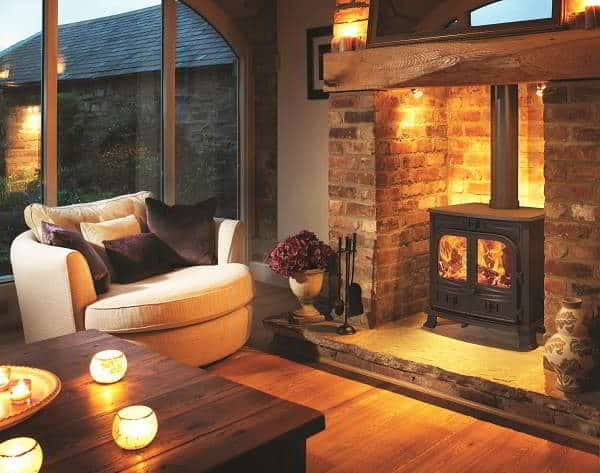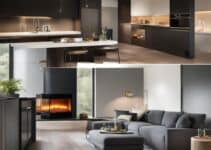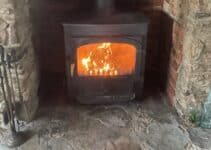During the winter months, there’s nothing better than a wood burning stove for bringing warmth and comfort to your home. And, as the cost of energy has skyrocketed in the last few years, wood burners are also a great way to economise on your fuel bill.
But does does my wood burner need fire bricks? All conventional wood burners or stoves will come with fire bricks installed. And they are essential for the effective running of your burner.
If you’re a proud owner of a wood burner you will be used to keeping up a maintenance programme to check it’s working properly. And those checks will include making sure the fire bricks are not damaged.
But if you’re buying a second-hand wood burner, you’ll want to look carefully at the fire bricks to make sure they are not damaged.
Or, more importantly, that they are not missing entirely. If they are you will need to restore them before using your wood burner.
We’ll look into the various reasons why fire bricks are an essential part of your wood burner set-up and many other burning questions on the hot topic of fire bricks.
Can you Use Regular Bricks in a Wood Stove?
If the fire bricks in your wood burner are damaged or broken, you may be tempted to save some cash by putting in some house bricks. It would be a false economy.
Wood burners generate higher temperatures than normal house bricks can’t withstand. They are simply not designed to withstand the extreme heat that is regularly created by a wood burner.
And if you were thinking that the outcome couldn’t possibly be that bad, think again. House bricks can crack, shatter, or even explode when exposed to the intense heat created by a wood fired stove.
But it goes beyond a mere safety issue. If having a wood burner is partly to save on heating costs, house bricks are going to be economically inefficient.
For a start, regular bricks don’t have the same insulating properties as fire bricks. Fire bricks have been specifically designed to slow down heat transfer.
Sometimes known as refractory bricks, they are made from special materials that are designed to provide insulation as well as protect the walls of the stove from excessive heat.

Plus, fire bricks can help maintain the high combustion temperatures necessary for efficient wood burning and prevent damage to the stove itself.
Suffice it to say that if you want to avoid damaging your wood stove or posing a significant fire risk to your home, you should replace damaged fire bricks with new fire bricks as recommended by the manufacturer of your burner.
What Can You Use Instead of Fire Bricks in Wood Stove?
Most major towns have wood burning stove suppliers. Failing that, there are so many options available directly or online from your stove manufacturer or other wood stove providers, it seems unlikely that you won’t be able to find fire bricks to suit.
Having said that, in an emergency, or if you are unable to find fire bricks to suit your burner, there are a few alternatives you can consider.
These options are certainly not as ideal as fire bricks and are provided here only for information purposes:
Refractory Cement
Refractory cement is a heat-resistant concrete that can be used to create a protective lining inside your wood stove.
It’s typically used in high-heat appliances and is designed to withstand high temperatures and provide some insulation.
Refractory cement is not as durable as fire bricks, however, so will probably require frequent maintenance and replacement. And, priced at around £30 for 25kg, it’s not a cheap option either.
Clay Bricks
In contrast to normal house bricks, solid clay bricks offer slightly more heat resistance and durability. They are quite cheap but not less so than fire bricks unless you have some already to hand.
And it’s important to bear in mind that clay bricks would only work as a temporary solution.
Clay bricks are likely to crack or deteriorate quickly under intense heat, so they may need to be replaced more frequently.
It’s also essential to use solid clay bricks without any holes or voids, as these can compromise their integrity when exposed to high temperatures and can break or explode.
Pumice Bricks
Pumice bricks are a reasonable second choice for fire bricks. They are lightweight and have good insulating properties, making them a suitable alternative to fire bricks. They can handle high temperatures relatively well as they are made from volcanic rock.
However, it’s important to ensure that the pumice bricks you choose are specifically designed for high temperatures.
Using any alternative to the fire bricks is always going to be less efficient. As well as this, using alternatives may pose a significant health or safety risk.
It is generally recommended to use fire bricks or consult the manufacturer for appropriate replacement materials to ensure the safe and efficient operation of your wood stove and the continued health of your family.
How Many Fire Bricks Do I Need for My Wood Stove?
Wood burners come in many shapes and sizes. They range from tiny potbellied stoves for caravans and narrow boats to huge wood-fired ranges that are used for cooking and for heating a home.
With this in mind, the number of fire bricks you need for your wood stove depends on the size and design of your specific stove.
If your wood burner’s bricks are broken or missing, consult the manufacturer’s documentation or contact the manufacturer directly. They can recommend how many bricks you’ll need to buy for your particular wood stove model.
And using any type of fire brick isn’t a good idea. Getting the right type of fire bricks is important because they are used as a protective barrier that helps retain heat and withstand the high temperatures generated by the fire inside.
The number of bricks needed will depend on the dimensions of the firebox and the thickness of the bricks.
If you don’t have access to the manufacturer’s recommendations, you can try to estimate the number of fire bricks based on the dimensions of your firebox. Measure the length, width, and height of the firebox and calculate its volume.
Then, check the dimensions of the fire bricks you plan to use and calculate how many bricks are needed to cover the entire interior surface of the firebox.
Bear in mind that the thicker the brick the more insulation you are creating, so choose a thickness that you think will suit your model.
A bonus tip is to have extra fire bricks on hand in case of damage and future replacement – you never know when you might need them and it will save you from having to wait for delivery in mid-winter.
And if you have any doubts about your choice of brick, or how to install or maintain them, it’s always recommended that you consult a professional.
Do Cast Iron Wood Stoves need Fire Bricks?
Cast iron can withstand extremely high heat, much higher than more modern steel or metal-plated wood burners. So if you have acquired this type of wood burner, fire bricks are (generally) not needed.
Not only can cast iron withstand the intense heat produced by a wood stove but it has excellent heat retention properties. The thick frame or body of a cast iron stove helps distribute heat evenly and prevent the exterior surfaces from becoming dangerously hot.
The cast iron material itself acts as a heat conductor, allowing the stove to radiate heat effectively into the room. It really is one of the most efficient metals for wood burner construction.
It’s always good to check, though, if your cast iron stove is the exception to the rule. Some models may include fire bricks or refractory panels as optional extras.
These extras can help increase heat retention and improve the efficiency of the stove by reflecting more heat back into the firebox. They also protect the cast iron frame from direct contact with the flames and prolong the lifespan of the stove.
Are Cracked Fire Bricks Dangerous?
The short answer is, yes, they can be. Cracked fire bricks can pose potential risks and should be addressed promptly.
While small cracks may not immediately impact the performance of the wood stove, they can lead to more significant damage over time.
Let’s look at some of the hazards in more detail:
- Cracks in fire bricks can weaken their structural integrity. This results in the bricks providing inadequate support and insulation. This can lead to heat transfer to surrounding material resulting in damage to the stove and overheating of the frame. This in turn becomes a hazard to those who come near it while it’s running, and, at worse, becomes a fire hazard.
- Heat will escape through the cracks in fire bricks which reduces the efficiency of the wood burner. This lower efficiency means a lower heat output and reduced combustion efficiency – in essence, you’ll waste energy.
- Cracked fire bricks can lead to improper airflow and heat distribution within the stove. A knock-on effect of this is a build-up of creosote in the chimney. Creosote is a highly flammable substance, and a significant accumulation can increase the risk of chimney fires.
- Over time, cracks in fire bricks can worsen and expand due to repeated exposure to high temperatures. This can result in damage or disintegration of fire bricks over time. If loose fragments fall into the firebox, they can interfere with the combustion process, and this could potentially damage other components within the stove.
It’s important to ensure that the stove maintains proper functionality, efficiency, and safety.
So, if you notice cracked fire bricks in your wood stove, it’s safest to consult the manufacturer’s guidance on replacing fire bricks or contact a professional to repair or replace the damaged fire bricks as soon as you can.
Cracked Fire Bricks in a Log Burner and What to do about it.
So, you’ve got cracked fire bricks and you want to maintain the safety and efficiency of your stove. Good for you!
Here are some steps that may help you:
- As part of the regular maintenance check of your wood burner, carefully examine the fire bricks to assess the severity and extent of any damage.
- If you observe damage but the cracks are superficial, monitor them closely to make sure they don’t become a more serious hazard. You may be able to use high-temperature mortar or refractory cement to seal minor cracks.
- If the cracks are significant or if the manufacturer advises against a repair, it’s best to replace the damaged fire bricks immediately.
- After replacing your cracked or damaged fire bricks, check if any loose fragments haven’t entered the firebox or ash pan. Loose pieces will interfere with the combustion process, so removing them is essential to avoid potential damage to other wood burner parts.
- If you are unsure about whether your fire bricks need replacing or can be repaired, contact the manufacturer of your log burner for guidance. They can provide specific recommendations based on the design and construction of your particular wood burner model.
Any tips mentioned above are general. If you decide to replace the fire bricks yourself, it’s essential you follow your wood burner manufacturer’s instructions to ensure a proper installation.
And remember, if you aren’t confident that you can replace the fire brick safely yourself, consult a professional. They can provide specific advice based on your log burner’s model and ensure that the necessary repairs or replacements are carried out safely and effectively.
Wood burners can pose a health risk to the home if they are maintained poorly, so always put safety first!
Fire bricks are essential components in wood burning stoves, providing insulation and protection against high temperatures.
They help to make the wood burner an efficient as well as aesthetically pleasing way to heat your home – if they are functioning properly! And making sure your fire bricks are fit for purpose will mean your wood burning stove will be a delightful feature for your home for decades to come.


